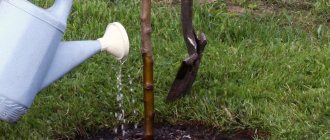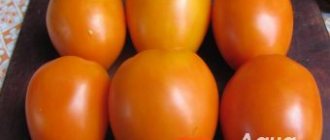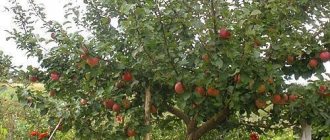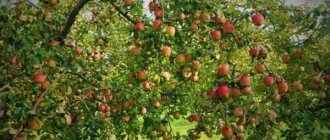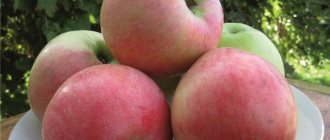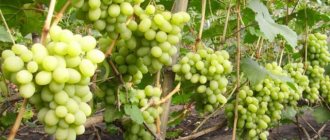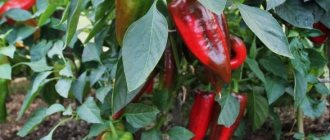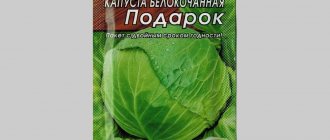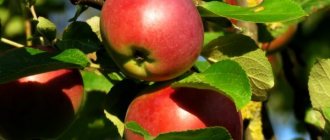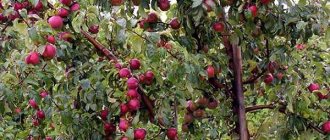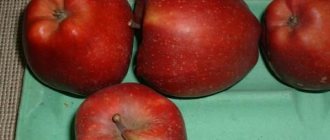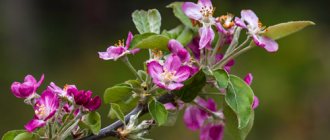Apple tree Gift to Count
A gift to Grafsky - the owner of excellent taste and product characteristics. The history of the creation of this late-winter variety and the giving of its name is interesting.
In the 1970s, specialists from the All-Russian Selection and Technological Institute of Horticulture, based on the old domestic Vyaznikovka and the elite D101 from the USA, developed a new variety of apple tree endowed with outstanding properties.
Harsh winter 1978-1979. devastated the garden of the variety testing station, and apple trees of traditionally frost-resistant varieties perished. The new, as yet unnamed seedlings survived, and in the summer they produced a good harvest of large, tasty fruits.
Breeders V.P. Yagunov, V.V. Kichin and N.G. Morozov dedicated their brainchild to Mikhail Grigorievich Grafsky, the legendary director of the state farm in the Vladimirov region, where the experimental station was located. The variety was included in the State Register for the Central Region in 2001.
Apple tree Gift to Grafsky - a vigorous standard . Without pruning, it grows up to 7 meters in the first 10 years of the tree's life.
The crown is obverse conical, spreading, medium dense, medium leafy. The branches are medium in thickness and length, light gray. The variety is characterized by high growth energy.
The leaves sit on a short, strong petiole, are short, wrinkled, densely green, with a jagged edge. Blooms profusely, white-pink flowers are small in size.
The fruits are large, often gigantic: the average weight is 250-300 grams , often up to 350. The shape of the apples is round-conical, the fruits are unequal. The skin is medium thick and hard, light yellow. The blush is blurry or has frequent stripes, dark red, with a well-defined purple tint and a waxy coating, covering the apple almost completely.
Apple tree fruit Gift to Grafsky on a branch.
The pulp is medium-juicy, medium-firm, yellow, almost fine-grained, with an apple aroma.
ATTENTION! When properly stored, apples retain excellent taste and beautiful presentation until April, and in particularly favorable conditions - until May-June.
additional characteristics
Gift to Grafsky belongs to traditional varieties. The apple tree is characterized by both typical characteristics of northern varieties and those that distinguish it from others.
Advantages and disadvantages
The undoubted advantages of the variety include:
- Frost resistance;
- High resistance to diseases and pests;
- Unpretentiousness, excellent adaptability to regional and local characteristics;
- Regular fruiting;
- Ability for long-term storage without loss of taste and commercial properties.
The Gift has no obvious shortcomings, only sometimes they note:
- Slight shedding of fruits after ripening;
- Low drought resistance.
Tree height
By the fourth year from the beginning of fruiting, the apple tree reaches its maximum height: without pruning it grows to 7-7.5 meters.
Crown width
The crown of an adult tree grows up to 4 meters in diameter.
Apple tree Gift to Count.
Annual growth
The variety is distinguished by intensive growth, which can be 1-1.2 meters per year.
Productivity
Gift to Grafsky bears fruit every season , the yield is high and varies from year to year. An adult tree produces 250 kg of apples ; in industrial orchards - up to 20 tons per hectare.
The Gift to Grafsky apple tree has good productivity.
Self-fertility
The variety is not self-fertile ; pollinating apple trees are required for fruit set.
Tasting assessment
Expert assessment of apples Gift to Grafsky 4.2-4.3 on a 5-point scale. Apples are medium juicy, sweet and sour, dense. The taste of the fruit is very good, dessert-like.
Ripe fruit Gift to Grafsky.
Winter hardiness
Apple trees of this variety can withstand temperatures down to -42 degrees . Gift to Grafsky is zoned for the Central region, suitable for growing in northern gardens; the apple tree shows good results in Siberia and the Urals.
Disease resistance
The variety is highly resistant to scab and fungal diseases.
Advantages and disadvantages
Tree during fruiting period
The Podarok Grafsky variety has many advantages, but no disadvantages have been noted, which makes this variety attractive to many gardeners. The variety has:
- High and annual productivity;
- large and tasty fruits;
- universal purpose of fruits;
- good transportability and keeping quality;
- excellent winter hardiness;
- drought resistance;
- high resistance to most fruit tree pests and pathogenic pathogens;
- beautiful appearance of the apple tree;
- Fruit shedding is insignificant.
Reviews
Gardeners and fruit lovers speak so highly of the Gift to Grafsky.
Galina. Nalchik. “I tried the apples, a gift to Grafsky. I was amazed by the size of the apples - they are huge! Very tasty and fragrant! The taste is pleasant sweet and sour. They say, and they stay there for a long time, almost until next summer. I will definitely plant this apple tree.”
Lidia Yakovlevna. Nakhodka. “My Gift to Grafsky has been bearing fruit for 5 years. By the fourth summer, about 10 apples were harvested, and by the seventh, there were already 4 buckets. Until April they lie perfectly in an ordinary basement, unlike others, they do not become “woolly”. They don't spoil at all! I recommend it to everyone, a very worthy apple!”
Anna Pavlovna. Saratov. “I heard about a new variety, looked at the description, photos and decided to plant it myself. My gift to Grafsky has been growing for 9 years. In winter it tolerates frosts of 40-45 degrees perfectly. It doesn't hurt anything, there are no pests either. Fruits every year. The apples are large, 200-250 grams each. I collect at the end of September, it could be later, but we have early frosts. They will definitely last until March, there are only a few of them yet, and by March we will already eat them. The preservation is excellent, they remain just as juicy and tasty.”
Features of planting and care
To grow a healthy tree and receive abundant harvests every year, you need to follow the rules of planting and care.
Landing
Deadlines
They practice spring and autumn planting of seedlings:
- You should start planting in the spring May and June plantings are more difficult to take root.
- Experienced gardeners believe that the best time is in the fall, 3-4 weeks before the onset of frost. In this case, the seedling gets time to take root, grows quickly in the spring, and fruiting occurs earlier.
Watch the video on how to plant an apple tree in spring:
This video shows planting an apple tree in the fall:
Technology
For the Podarok Grafsky apple tree, choose sunny areas protected from cold winds . For tall trees, hills and places with deep groundwater are suitable: their standing should be no higher than 2.5-3 m, and better - 3.5 meters.
IMPORTANT! Apple trees need to be planted on loamy, fertile, moist, but well-drained soils. They should not be located in lowlands where melt or rainwater stagnates and cold air accumulates.
The pit is prepared 3 weeks before planting in the fall, in September for spring planting. The width of the seat is 80-100 cm, depth 60-80.
A tall, strong stake is driven into the center, which will become a support for the young seedling. Drainage, mineral fertilizers, 2 buckets of rotted compost or manure are placed at the bottom of the hole, and fertile soil is covered on top.
A seedling is placed on the resulting mound, straightening the roots. Cover with soil, gently shaking the tree to compact the soil around the roots.
Apple tree planting diagram.
When planting is completed, the soil around the seedling is lightly compacted , a circle around the trunk is arranged, and it is framed with a side. The planting is watered abundantly with two or three buckets of water.
Watch the video on how to properly prepare a planting hole:
Sequence of care
Caring for an apple tree, like any other fruit tree, consists of:
- loosening the soil and watering;
- root and foliar feeding;
- pruning;
- prevention and control of pests and diseases.
Did you know? Archaeological excavations indicate that humans have been eating apples for at least 8,500 years.
Watering and loosening
The most vulnerable point of the Podarok Grafsky apple tree is its insufficient ability to withstand drought. Therefore, gardeners recommend watering this tree generously at least 5 times during the growing season, increasing the frequency of watering during dry times. A sure sign that the tree does not have enough moisture is the drying tips of the leaves. Weekly watering is considered optimal.
To destroy the crust that forms on the ground after rain or watering, which prevents the supply of oxygen to the root system, it is necessary to loosen it after each moistening of the soil. The frequency of labor-intensive loosening of the soil can be reduced by mulching the tree trunk circle with straw, pine needles, peat, humus, rotted compost, and sawdust.
Fertilizers
Fertilizers applied to the soil during planting are enough for the seedling to last a year. Then in the spring it is necessary to enrich the soil with nitrogen using organic fertilizers in the form of a solution of chicken droppings, slurry or rotted humus. A decade before flowering, it is useful to spray the tree with a urea solution. This operation must be repeated during the period of ovary formation.
Also, in the summer and autumn, after rain or watering, potassium and phosphorus fertilizers are added to the soil, necessary for the formation and development of fruits. After harvesting, the soil is enriched with nitrogen-free complex mineral fertilizers, since there is enough nitrogen in the humus, which is buried into it when digging the soil.
Video: fertilizing an apple tree
Trimming
- The apple variety Podarok Grafsky is characterized by its vigorous growth, which is why it requires regular pruning. It promotes:
- sanitary cleaning of the tree from branches damaged during wintering or after extreme weather conditions;
- correct formation of the trunk;
- the formation of skeletal branches in the crown;
- increasing productivity by removing last season's branches;
- making it easier to care for the tree and collect fruits from it;
- apple tree rejuvenation;
- preparing it for winter.
Pruning of branches must be done using a sharply sharpened instrument disinfected with copper sulfate. In addition to mechanical thinning of the crown, it is also useful to remove excess ovaries located nearby, leaving a maximum of 2 of them, which allows you to get large and beautiful apples.
Wounds on the tree are also treated with the same 3% concentration. Important! When pruning, you should proceed from the rule that does not allow you to trim more than a quarter of the total mass of branches.
Preparing for winter
An apple tree that can withstand frosts down to -42°C does not require any special shelter from the cold. But before winter, it is useful to whiten the tree trunk with slaked lime with the addition of insecticides and strong-smelling substances to protect it from pests and rodents.
Features of cultivation
When growing an apple tree Gift to Grafsky, some features are taken into account:
- The soil around the trunk should be loose, free from weeds and other crops;
- It is necessary to generously water the apple tree 4-5 times per season; during dry periods this should be done more often - 2-3 times a month.
Agricultural technology
When growing the variety, standard agrotechnical practices for apple trees are used:
- Sanitary and formative pruning in autumn and spring;
- Root and foliar feeding with mineral and organic fertilizers;
- Regular abundant watering;
- Weeding the tree trunk space, loosening the soil, mulching;
- Protection from pests and diseases.
Pruning and crown formation
In early spring, before the sap begins to flow, sanitary pruning . Remove weak, broken, damaged branches, and excess young shoots.
During the season, cut off broken and damaged branches and the current year's growth.
In autumn the crown is formed. Get rid of branches that grow towards the trunk or parallel to the central conductor. Shorten annual shoots by 25-30%.
In the video below you can see a detailed lesson on pruning apple trees:
Pollinator varieties
The Podarok Grafsky apple tree variety is not self-fertile, so pollinating apple trees should be placed next to it. The following varieties are considered the best:
- Sinap northern;
- Student;
- Moscow later.
Northern Sinap.
Student.
Moscow later.
Pests and diseases
Particularly dangerous pests and diseases of the apple tree can cause a significant reduction in fruit yield. In order to promptly stop their negative impact on the fruit tree, you need to know their distinctive features and how to combat them. A description of apple tree pests with photos can be found in this article.
Aphid
The pest has an oval green body with an average length of 2-3 mm. The aphid feeds on cell sap as a result of severe damage, the leaves begin to curl. In addition, the pest is a carrier of dangerous viral diseases. In a short period of time, aphids can form large colonies on the lower part of young shoots. Control measures: spraying with insecticides Karbofos, Metafos and BI-58.
leaf roller
The pest feeds on fruits, buds and leaves of apple trees. An adult is a butterfly up to 2.5 cm long. The damage is caused by the larvae that appear simultaneously with the budding of the buds. Butterfly eggs and caterpillars overwinter in cocoons located in cracks in trunks. Control measures: spraying the tree crowns with Avant, Decis-pro, Inta-Vir insecticides.
codling moth
The adult is a white butterfly that is capable of laying eggs en masse. As a result, pink caterpillars emerge from the eggs, which intensively bite into the apples and feed on the pulp. As a result, severely damaged fruits stop growing and subsequently fall off.
During a season, up to 5 generations of this pest may be born. Adult caterpillars overwinter in dense cocoons located in cracks in the bark. For effective control, you need to carry out proper pruning and treatment with insecticides Fitoverm, Karate-Zeon and Kinmiks.
Scab
This is a fungal disease that thrives in humid climates. The main signs of this disease are swamp-colored spots on fruits and foliage. Damaged leaves dry out, and the fruits harden and crack. Control measures: use of fungicides Fitoflavin, Raek and Gamair.
Apple tree disease - black cancer
The disease destroys the tree from the inside. In appearance, the affected apple tree takes on the appearance of a burnt tree. The main method of combating this disease is to identify it at an early stage. After this, the affected parts of the tree are pruned and destroyed. The cut areas are disinfected with copper sulfate, and the tree itself is treated with a copper-containing fungicide. How to treat black apple tree cancer, read the material from our experts.
Fruit rot
A fungal disease that affects apple fruits. The main signs of the disease are cracking of the bark, the presence of unfallen leaves, and small ovaries. In addition, the surface of the bark is dotted with white pustules. Fruits are massively affected during the ripening period. The peel is covered with yellow and gray spots. Subsequently, the pulp softens greatly. Control measures: in the budding phase, spraying with the drug Skor. Find out what harm fruit rot causes from this article.
Features of ripening and fruiting
Beginning of fruiting
Grafsky's gift gives the first significant harvest in the 4-5 season after planting the seedling . This is an average indicator of early pregnancy.
ADVICE! Selecting a seedling on a weak-growing rootstock will allow you to bring fruiting closer; in this case, the first harvest is harvested 2-3 years after planting.
The fruits are placed on perennial ringlets, sometimes formed on two-year-old wood.
Deadlines
Blooms
Podarok Grafsky apple trees bloom in May . The exact timing depends on the regional weather conditions and microclimate of the site.
Fruit ripening
Harvesting maturity occurs in late September or early October . In a month, consumer maturity sets in.
Gift to Grafsky apples ripen in September-October.
Fruit storage
In a dark, dry room at a temperature of 0 to +5 degrees, Gift to Grafsky apples are stored from October to April. In industrial storage facilities in a special gas environment, the fruits last well until May-June. Podarok Grafsky is superior to other late-winter varieties in terms of shelf life.
Apple tree planting technology
You can achieve the maximum yield from a Siberian apple tree by following agricultural planting techniques and systematically caring for the plant.
It is important to choose the right place for the fruit tree to grow and to protect the apple tree from insect pests.
Required soil composition
Apple tree A gift for gardeners - an unpretentious plant. Can grow on various types of soil. The soil acidity is preferably neutral; organic fertilizers are applied directly to the planting hole. Avoid wetlands.
Selecting and preparing a landing site
The location for the orchard is chosen in advance. Preference should be given to the eastern or south-eastern side of the area, without drafts or shading. In lowlands and marshy soils, apple trees grow poorly and yields decrease. Drainage must be installed at the bottom of the planting hole.
Dimensions and depth of the landing pit
The optimal parameters for the planting hole are 1 meter by 1 meter. The distance between plants should be 3-4 meters. During group landings, a checkerboard order is observed.
Timing and step-by-step algorithm for planting a seedling
The landing algorithm is simple. Drainage made of expanded clay and sand is installed in the planting hole, and horse manure or humus mixed with wood ash and sand is poured on top. Add 1 tablespoon of urea or superphosphate. In the center of the hole, a mound is formed from the main soil, on which the seedling is placed, carefully straightening the roots. The plant is sprinkled with earth, watered, the earth is pressed down, and the tree trunk area is mulched.
Subspecies and options
On a semi-dwarf rootstock, the tree grows up to 4-4.5 meters and forms a more compact crown. It begins to bear fruit 1-2 years earlier than on the seed rootstock and bears fruit for 25-30 years.
On a dwarf rootstock, the height of the apple tree is 2.5-3.5 meters , the crown is narrow. Fruiting from the first or second year, the yield is high. Productivity period is 15-20 years.
Apple trees on weak-growing rootstocks are less winter-hardy because their root system lies high.
It is worth taking care of insulating the tree trunk space; for this, mulch compounds (humus, leaf litter, compost, rotted manure, sawdust) are poured in a layer of 5-10 cm.
In winters with little snow, additional snow is poured under the apple tree.
Important! Such apple trees can be placed in areas with high groundwater.
The compact shaped apple tree reaches a height of 2.5 meters. The crown is compact. Fruit weight 120-210 g.
Growing in regions
In the Moscow region and in the central zone, the Podarok Grafsky apple tree has optimal climatic conditions, the variety is zoned for the Central region . Only the terrain features and microclimate of the site should be taken into account.
The Moscow region and the Middle Belt are the optimal areas for growing Gift to Grafsky.
In Siberia, this apple tree is grown in regions where winter temperatures do not fall below 40-42 degrees below zero. is known .
